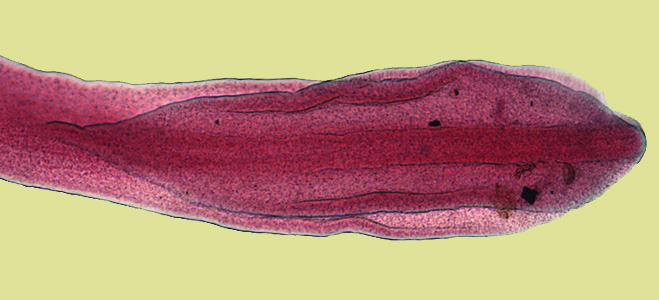Diphyllobothriasis laboratory tests: Difference between revisions
No edit summary |
|||
| Line 2: | Line 2: | ||
{{Diphyllobothriasis}} | {{Diphyllobothriasis}} | ||
{{CMG}} | {{CMG}} | ||
==Laboratory Findings== | ==Laboratory Findings== | ||
| Line 11: | Line 10: | ||
====Eggs==== | ====Eggs==== | ||
Diphyllobothrium spp. eggs are oval or ellipsoidal and range in size from 55 to 75 µm by 40 to 50 µm. There is an operculum at one end that can be inconspicuous, and at the opposite (abopercular) end is a small knob that can be barely discernible. The eggs are passed in the stool unembryonated. | Diphyllobothrium spp. eggs are oval or ellipsoidal and range in size from 55 to 75 µm by 40 to 50 µm. There is an operculum at one end that can be inconspicuous, and at the opposite (abopercular) end is a small knob that can be barely discernible. The eggs are passed in the stool unembryonated. | ||
---- | |||
Shown below is an egg of D. latum in an iodine-stained wet mount. Note the knob at the abopercular end in Figure | |||
[[Image:Dlatum egg OR2.jpg|250px|center]] | [[Image:Dlatum egg OR2.jpg|250px|center]] | ||
---- | ---- | ||
Shown below is an egg of Diphyllobothrium latum | |||
[[Image:D latum CAP1.jpg|250px|center]] | [[Image:D latum CAP1.jpg|250px|center]] | ||
| Line 23: | Line 22: | ||
Adults of Diphyllobothrium spp. may be 4-10 meters in length. The scolex is elongated, 1mm by 3mm, with two shallow, longitudinal grooves. As proglottids mature, they may break off from the stroblia, in lengths containing few to many segments. Proglottids are broader than they are long and range from 2 to 4 mm long by 10 to 12 mm wide. The uterus is coiled in rosette appearance and the genital pore is at the center of the proglottid. There are numerous testes that appear in the lateral fields of each proglottid. | Adults of Diphyllobothrium spp. may be 4-10 meters in length. The scolex is elongated, 1mm by 3mm, with two shallow, longitudinal grooves. As proglottids mature, they may break off from the stroblia, in lengths containing few to many segments. Proglottids are broader than they are long and range from 2 to 4 mm long by 10 to 12 mm wide. The uterus is coiled in rosette appearance and the genital pore is at the center of the proglottid. There are numerous testes that appear in the lateral fields of each proglottid. | ||
---- | |||
Shown below is a section of an adult D. latum containing many proglottids. The scolex was not present in this specimen. Image courtesy of the Florida State Public Health Laboratory. | |||
[[Image:Dlatum whole worm FL.jpg|250px|center]] | [[Image:Dlatum whole worm FL.jpg|250px|center]] | ||
---- | ---- | ||
Shown below is a close-up of a few of the proglottids from the specimen above, showing the rosette-shaped uterus at the center of each proglottid. | |||
[[Image:Dlatum proglottid FL 1.jpg|250px|center]] | [[Image:Dlatum proglottid FL 1.jpg|250px|center]] | ||
---- | ---- | ||
Shown below is carmine-stained proglottids of D. latum, showing the rosette-shaped ovaries. | |||
[[Image:Dlatum proglottid.jpg|250px|center]] | [[Image:Dlatum proglottid.jpg|250px|center]] | ||
---- | ---- | ||
Shown below is carmine-stained proglottids of D. latum, showing the rosette-shaped ovaries. | |||
[[Image:Dlatum proglottid2.jpg|250px|center]] | [[Image:Dlatum proglottid2.jpg|250px|center]] | ||
| Line 44: | Line 45: | ||
---- | ---- | ||
Shown below is scolex of D. latum | |||
Revision as of 16:48, 5 December 2012
|
Diphyllobothriasis Microchapters |
|
Diagnosis |
|---|
|
Treatment |
|
Case Studies |
|
Diphyllobothriasis laboratory tests On the Web |
|
American Roentgen Ray Society Images of Diphyllobothriasis laboratory tests |
|
Risk calculators and risk factors for Diphyllobothriasis laboratory tests |
Editor-In-Chief: C. Michael Gibson, M.S., M.D. [1]
Laboratory Findings
Microscopy
Microscopic identification of eggs in the stool is the basis of specific diagnosis. Eggs are usually numerous and can be demonstrated without concentration techniques. Examination of proglottids passed in the stool is also of diagnostic value.
Eggs
Diphyllobothrium spp. eggs are oval or ellipsoidal and range in size from 55 to 75 µm by 40 to 50 µm. There is an operculum at one end that can be inconspicuous, and at the opposite (abopercular) end is a small knob that can be barely discernible. The eggs are passed in the stool unembryonated.
Shown below is an egg of D. latum in an iodine-stained wet mount. Note the knob at the abopercular end in Figure
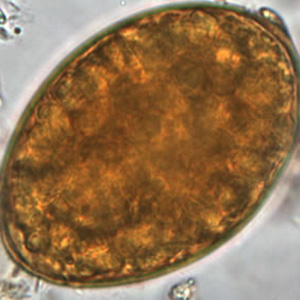
Shown below is an egg of Diphyllobothrium latum
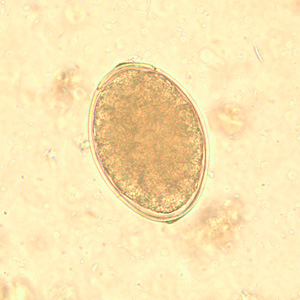
Adults
Adults of Diphyllobothrium spp. may be 4-10 meters in length. The scolex is elongated, 1mm by 3mm, with two shallow, longitudinal grooves. As proglottids mature, they may break off from the stroblia, in lengths containing few to many segments. Proglottids are broader than they are long and range from 2 to 4 mm long by 10 to 12 mm wide. The uterus is coiled in rosette appearance and the genital pore is at the center of the proglottid. There are numerous testes that appear in the lateral fields of each proglottid.
Shown below is a section of an adult D. latum containing many proglottids. The scolex was not present in this specimen. Image courtesy of the Florida State Public Health Laboratory.
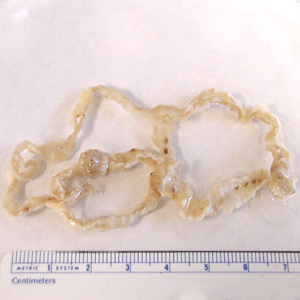
Shown below is a close-up of a few of the proglottids from the specimen above, showing the rosette-shaped uterus at the center of each proglottid.
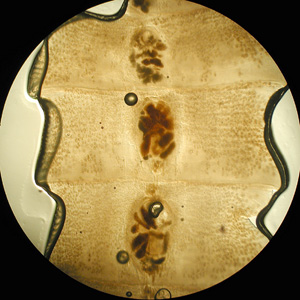
Shown below is carmine-stained proglottids of D. latum, showing the rosette-shaped ovaries.
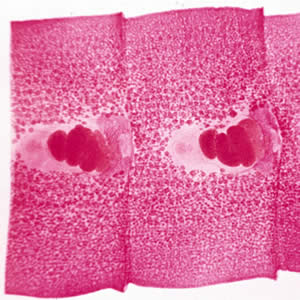
Shown below is carmine-stained proglottids of D. latum, showing the rosette-shaped ovaries.
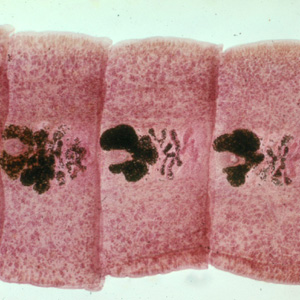
Shown below is scolex of D. latum
